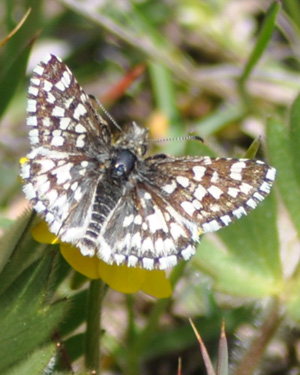Laguna Mountains skipper facts for kids
Quick facts for kids Laguna Mountains skipper |
|
|---|---|
 |
|
| Conservation status | |
| Scientific classification |
|
| Kingdom: | Animalia |
| Phylum: | Arthropoda |
| Class: | Insecta |
| Order: | Lepidoptera |
| Family: | Hesperiidae |
| Genus: | Pyrgus |
| Species: |
P. ruralis
|
| Subspecies: |
P. r. lagunae
|
| Trinomial name | |
| Pyrgus ruralis lagunae Scott, 1981
|
|
The Laguna Mountains skipper (Pyrgus ruralis lagunae) is a small, rare butterfly. It belongs to the family Hesperiidae. This butterfly is a subspecies of the Pyrgus ruralis, also known as the rural skipper.
Contents
About the Laguna Mountains Skipper
The Laguna Mountains skipper is a small butterfly. It has black and white checkered wings. Its wingspan is about 1 inch (3 cm). This butterfly flies very fast and in a zig-zag pattern.
This special butterfly is endangered. You can only find it in Southern California. It lives in high places in the Cleveland National Forest near San Diego, California. Male skippers often have more white on their wings than females.
The Laguna Mountains skipper is one of two types of rural skippers. The other type, Pyrgus ruralis ruralis, lives in a much larger area. That area stretches from British Columbia all the way to Central California.
Where the Skipper Lives
The Laguna Mountains skipper lives only in Southern California. It mostly lives in wet meadows high up in the mountains. These meadows are found in yellow pine forests. You can find them in the Laguna Mountains and Palomar Mountain. They live at heights of about 4,000 to 6,000 feet (1,200 to 1,800 m).
Scientists think there is one group of skippers in the Laguna Mountains. On Palomar Mountain, there might be four separate groups. The biggest group in each place has about 100 to 250 butterflies.
The young skippers, called larvae, eat a plant called Cleveland's horkelia (Horkelia clevelandii). This plant grows under yellow pines in rocky soil. It is very important for the larvae to grow and survive. Adult skippers also drink nectar from Cleveland's horkelia. The number of skippers depends a lot on how much Cleveland's horkelia is available.
Life Cycle
Adult Laguna Mountains skippers fly during two main times each year. One flight season is in the middle of spring. The other is in late summer.
Female skippers lay their eggs on the underside of the outer leaves of the Cleveland's horkelia plant. The eggs hatch in about 12 to 14 days. It takes about seven weeks for the young larvae to grow into full adult butterflies.
Why the Population is Declining
The number of Laguna Mountains skippers is going down. This is mostly because their habitat is being destroyed. Since the young skippers only eat Cleveland's horkelia, it's hard for them to survive if that plant disappears.
Their habitat is being destroyed by building new cities and farms. Outdoor activities can also harm their homes. A common problem is when cattle overgraze and step on the Cleveland's horkelia. This breaks up the areas where the skippers live.
Because these butterflies have small and sensitive populations, any changes to their habitat can hurt them a lot. Also, if there is a dry season, the Cleveland's horkelia plants can die. This then causes the skipper population to go down. The Laguna Mountains skipper has no known predators. So, changes in their numbers are usually due to changes in their habitat or unexpected environmental events.
The Laguna Mountains skipper was listed as a federally endangered species on January 17, 1997. This means it gets special protection by the government. In January 2007, the Department of the Interior and the Fish and Wildlife Service set aside special areas for the skipper. These areas are called "critical habitat." Critical habitat includes places where the butterfly lives now and other areas that are needed for its survival. About 6,242 acres (25 km²) in Southern California were named as critical habitat. Protecting these areas is very important for helping the Laguna Mountains skipper survive.


